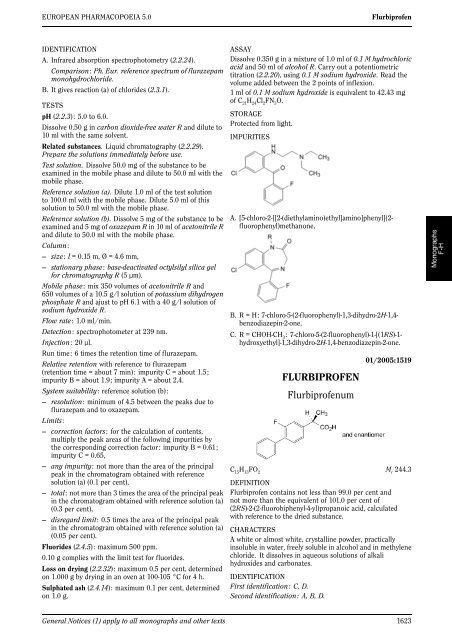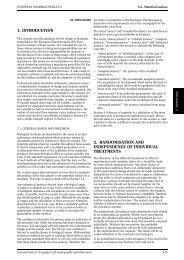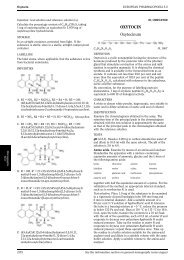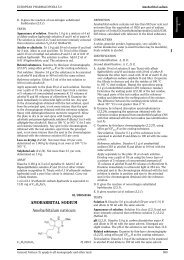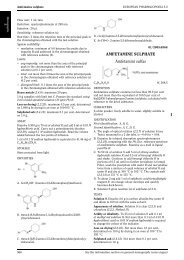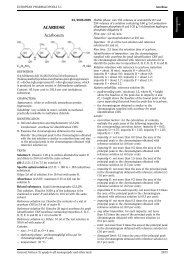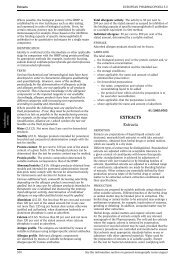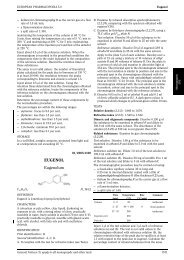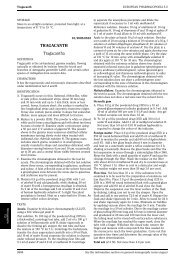FLURBIPROFEN Flurbiprofenum
FLURBIPROFEN Flurbiprofenum
FLURBIPROFEN Flurbiprofenum
You also want an ePaper? Increase the reach of your titles
YUMPU automatically turns print PDFs into web optimized ePapers that Google loves.
EUROPEAN PHARMACOPOEIA 5.0 Flurbiprofen<br />
IDENTIFICATION<br />
A. Infrared absorption spectrophotometry (2.2.24).<br />
Comparison: Ph. Eur. reference spectrum of flurazepam<br />
monohydrochloride.<br />
B. It gives reaction (a) of chlorides (2.3.1).<br />
ASSAY<br />
Dissolve 0.350 g in a mixture of 1.0 ml of 0.1 M hydrochloric<br />
acid and 50 ml of alcohol R. Carry out a potentiometric<br />
titration (2.2.20), using 0.1 M sodium hydroxide. Readthe<br />
volume added between the 2 points of inflexion.<br />
1mlof0.1 M sodium hydroxide is equivalent to 42.43 mg<br />
of C21H24Cl2FN3O. STORAGE<br />
Protected from light.<br />
IMPURITIES<br />
TESTS<br />
pH (2.2.3): 5.0to6.0. Dissolve 0.50 g in carbon dioxide-free water R and dilute to<br />
10mlwiththesamesolvent.<br />
Related substances. Liquid chromatography (2.2.29).<br />
Prepare the solutions immediately before use.<br />
Test solution. Dissolve50.0mgofthesubstancetobe<br />
examined in the mobile phase and dilute to 50.0 ml with the<br />
mobile phase.<br />
Reference solution (a). Dilute 1.0 ml of the test solution<br />
to 100.0 ml with the mobile phase. Dilute 5.0 ml of this<br />
solution to 50.0 ml with the mobile phase.<br />
Reference solution (b). Dissolve 5 mg of the substance to be A. [5-chloro-2-[[2-(diethylamino)ethyl]amino]phenyl](2-<br />
examined and 5 mg of oxazepam R in 10 ml of acetonitrile R<br />
and dilute to 50.0 ml with the mobile phase.<br />
Column:<br />
— size: l =0.15m,Ø=4.6mm,<br />
— stationary phase: base-deactivated octylsilyl silica gel<br />
for chromatography R (5 µm).<br />
Mobile phase: mix 350 volumes of acetonitrile R and<br />
650 volumes of a 10.5 g/l solution of potassium dihydrogen<br />
phosphate R and ajust to pH 6.1 with a 40 g/l solution of<br />
fluorophenyl)methanone,<br />
sodium hydroxide R.<br />
Flow rate: 1.0ml/min.<br />
B. R = H: 7-chloro-5-(2-fluorophenyl)-1,3-dihydro-2H-1,4benzodiazepin-2-one,<br />
Detection: spectrophotometer at 239 nm.<br />
Injection: 20µl.<br />
C. R = CHOH-CH3: 7-chloro-5-(2-fluorophenyl)-1-[(1RS)-1hydroxyethyl]-1,3-dihydro-2H-1,4-benzodiazepin-2-one.<br />
Run time: 6 times the retention time of flurazepam.<br />
Relative retention with reference to flurazepam<br />
01/2005:1519<br />
(retention time = about 7 min): impurity C = about 1.5;<br />
impurity B = about 1.9; impurity A = about 2.4.<br />
<strong>FLURBIPROFEN</strong><br />
System suitability: reference solution (b):<br />
— resolution: minimum of 4.5 between the peaks due to<br />
flurazepam and to oxazepam.<br />
Limits:<br />
— correction factors: for the calculation of contents,<br />
multiply the peak areas of the following impurities by<br />
the corresponding correction factor: impurity B = 0.61;<br />
impurity C = 0.65,<br />
<strong>Flurbiprofenum</strong><br />
— any impurity: not more than the area of the principal<br />
peak in the chromatogram obtained with reference<br />
C15H13FO2 Mr 244.3<br />
solution (a) (0.1 per cent),<br />
DEFINITION<br />
— total: not more than 3 times the area of the principal peak Flurbiprofen contains not less than 99.0 per cent and<br />
in the chromatogram obtained with reference solution (a) not more than the equivalent of 101.0 per cent of<br />
(0.3 per cent),<br />
(2RS)-2-(2-fluorobiphenyl-4-yl)propanoic acid, calculated<br />
— disregard limit: 0.5 times the area of the principal peak<br />
with reference to the dried substance.<br />
in the chromatogram obtained with reference solution (a)<br />
(0.05 per cent).<br />
CHARACTERS<br />
A white or almost white, crystalline powder, practically<br />
Fluorides (2.4.5): maximum 500 ppm.<br />
insoluble in water, freely soluble in alcohol and in methylene<br />
0.10 g complies with the limit test for fluorides.<br />
Loss on drying (2.2.32): maximum 0.5 per cent, determined<br />
chloride. It dissolves in aqueous solutions of alkali<br />
hydroxides and carbonates.<br />
on 1.000 g by drying in an oven at 100-105 °C for 4 h. IDENTIFICATION<br />
Sulphated ash (2.4.14): maximum 0.1 per cent, determined First identification: C, D.<br />
on 1.0 g.<br />
Second identification: A, B, D.<br />
GeneralNotices(1)applytoallmonographsandothertexts 1623
Flurbiprofen EUROPEAN PHARMACOPOEIA 5.0<br />
A. Melting point (2.2.14) : 114 °C to 117 °C.<br />
B. Dissolve 0.10 g in 0.1 M sodium hydroxide and dilute to<br />
100.0 ml with the same alkaline solution. Dilute 1.0 ml of<br />
the solution to 100.0 ml with 0.1 M sodium hydroxide.<br />
Examined between 230 nm and 350 nm (2.2.25), the<br />
solution shows an absorption maximum at 247 nm. The<br />
specific absorbance at the maximum is 780 to 820.<br />
C. Examine by infrared absorption spectrophotometry<br />
(2.2.24), comparing with the spectrum obtained with<br />
flurbiprofenCRS. D.Mixabout5mgwith45mgofheavy magnesium oxide R<br />
and ignite in a crucible until an almost white residue is<br />
obtained (usually less than 5 min). Allow to cool, add 1 ml<br />
of water R, 0.05mlofphenolphthalein solution R1 and<br />
about 1 ml of dilute hydrochloric acid R to render the<br />
solution colourless. Filter. To a freshly prepared mixture<br />
of 0.1 ml of alizarin S solution R and 0.1 ml of zirconyl<br />
nitrate solution R add 1.0 ml of the filtrate. Mix, allow to<br />
stand for 5 min and compare the colour of the solution<br />
with that of a blank prepared in the same manner. The<br />
test solution is yellow and the blank is red.<br />
TESTS<br />
Appearance of solution. Dissolve1.0ginmethanol R and<br />
dilute to 10 ml with the same solvent. The solution is clear<br />
(2.2.1) and colourless (2.2.2, Method I).<br />
Optical rotation (2.2.7). Dissolve 0.50 g in methanol R and<br />
dilute to 20.0 ml with the same solvent. The angle of optical<br />
rotation is −0.1° to + 0.1°.<br />
Related substances. Examine by liquid chromatography<br />
(2.2.29).<br />
Test solution. Dissolve 0.20 g of the substance to be<br />
examined in a mixture of 45 volumes of acetonitrile R and<br />
55 volumes of water R and dilute to 100.0 ml with the same<br />
mixture of solvents.<br />
Reference solution (a). Dilute 1.0 ml of the test solution<br />
to50.0mlwithamixtureof45volumesofacetonitrile R<br />
and 55 volumes of water R. Dilute1.0mlofthesolutionto<br />
10.0 ml with a mixture of 45 volumes of acetonitrile R and<br />
55 volumes of water R.<br />
Reference solution (b). Dissolve 10.0 mg of flurbiprofen<br />
impurity A CRS in a mixture of 45 volumes of acetonitrile R<br />
and 55 volumes of water R and dilute to100.0 ml with the<br />
same mixture of solvents. Dilute 10.0 ml of this solution to<br />
100.0mlwithamixtureof45volumesofacetonitrile R and<br />
55 volumes of water R.<br />
Reference solution (c). Dissolve 10 mg of the substance to<br />
be examined in a mixture of 45 volumes of acetonitrile R<br />
and 55 volumes of water R and dilute to 100.0 ml with the<br />
same mixture of solvents. Dilute 1.0 ml of the solution to<br />
10.0 ml with reference solution (b).<br />
The chromatographic procedure may be carried out using:<br />
— a stainless steel column 0.15 m long and 3.9 mm in<br />
internal diameter packed with octadecylsilyl silica gel for<br />
chromatography R (5 µm),<br />
— as mobile phase at a flow rate of 1 ml/min a mixture<br />
of 5 volumes of glacial acetic acid R, 35 volumes of<br />
acetonitrile R and 60 volumes of water R,<br />
— as detector a spectrophotometer set at 254 nm.<br />
Inject 10 µl of reference solution (c). Adjust the sensitivity<br />
of the system so that the heights of the two principal peaks<br />
in the chromatogram obtained are at least 40 per cent of<br />
the full scale of the recorder. The test is not valid unless the<br />
resolution between the peak corresponding to impurity A<br />
and the peak corresponding to flurbiprofen is at least 1.5.<br />
Inject 10 µl of the test solution and of reference solutions (a)<br />
and (b). Continue the chromatography for twice the retention<br />
time of flurbiprofen. In the chromatogram obtained with<br />
the test solution the area of any peak corresponding to<br />
impurity A is not greater than the area of the peak in the<br />
chromatogram obtained with reference solution (b) (0.5 per<br />
cent); the area of any peak, apart from the principal peak<br />
and the peak due to impurity A, is not greater than the area<br />
of the principal peak in the chromatogram obtained with<br />
reference solution (a) (0.2 per cent) and the sum of the areas<br />
of any such peaks is not greater than five times the area<br />
of the principal peak in the chromatogram obtained with<br />
reference solution (a) (1.0 per cent). Disregard any peak with<br />
an area less than 0.1 times that of the principal peak in the<br />
chromatogram obtained with reference solution (a) (0.02 per<br />
cent).<br />
Heavy metals (2.4.8). Dissolve 2.0 g in a mixture of<br />
10 volumes of water R and 90 volumes of methanol R and<br />
dilute to 20 ml with the same mixture of solvents. 12 ml<br />
of the solution complies with limit test B for heavy metals<br />
(10 ppm). Prepare the standard using lead standard solution<br />
(1 ppm Pb) obtained by diluting lead standard solution<br />
(100 ppm Pb) R with a mixture of 10 volumes of water R and<br />
90 volumes of methanol R.<br />
Loss on drying (2.2.32). Not more than 0.5 per cent,<br />
determined on 1.000 g by drying at 60 °C at a pressure not<br />
exceeding 0.7 kPa for 3 h.<br />
Sulphated ash (2.4.14). Not more than 0.1 per cent,<br />
determined on 1.0 g in a platinum crucible.<br />
ASSAY<br />
Dissolve 0.200 g in 50 ml of alcohol R. Titratewith<br />
0.1 M sodium hydroxide, determining the end-point<br />
potentiometrically (2.2.20).<br />
1mlof0.1 M sodium hydroxide is equivalent to 24.43 mg<br />
of C 15H 13FO 2.<br />
IMPURITIES<br />
A. R = R′ =H:(2RS)-2-(biphenyl-4-yl)propanoic acid,<br />
B. R = CH(CH 3)-CO 2H: 2-(2-fluorobiphenyl-4-yl)-2,3dimethylbutanedioic<br />
acid,<br />
C. C. R = OH, R′ =F:(2RS)-2-(2-fluorobiphenyl-4-yl)-2hydroxypropanoic<br />
acid,<br />
D. R = CO-CH 3:1-(2-fluorobiphenyl-4-yl)ethanone,<br />
E. R = CO 2H: 2-fluorobiphenyl-4-carboxylic acid.<br />
1624 See the information section on general monographs (cover pages)


